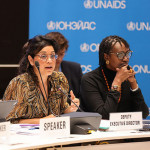World AIDS Day is a time to remember those we’ve lost to HIV/AIDS, celebrate our successes in saving and improving the lives of people living with HIV, and renew our commitment to ending the HIV/AIDS epidemic in the U.S. and around the world.
Last week I was honored to join FDA staff in viewing the panels from the AIDS Memorial Quilt that are on display at FDA’s White Oak Campus through January 31, 2020. The handmade quilt honors the lives of those lost to HIV and AIDS, and is a powerful testament to the impact of the AIDS epidemic on friends, families, and communities across our country. It is a touchstone to the time when we did not have effective therapies to treat and prevent HIV.
We have made incredible progress since World AIDS Day was first observed in 1988. Thanks to the power of groundbreaking medical research and the dedication of scientists, physicians, nurses, epidemiologists, researchers, government regulators, and, most importantly, people living with HIV and their advocates, we have shifted the prognosis for HIV from a death sentence to a manageable illness with near normal life expectancy, if appropriately treated. We also have highly effective medications to prevent the acquisition of HIV. The work of FDA staff to eradicate this disease has made all of us part of the historical triumph that has transformed the lives of those with HIV and AIDS.
Deborah L. Birx, M.D., U.S. Global AIDS Coordinator and U.S. Special Representative for Global Health Diplomacy at the U.S. Department of State, and I provided a brief update, “Ending the HIV/AIDS Epidemic: Community by Community,” that describes some of the important work being done across the U.S. government. For example, we have strong leadership both at home, in the newly launched Ending the HIV Epidemic: A Plan for America (EHE) initiative, and abroad through the U.S. President’s Emergency Plan for AIDS Relief (PEPFAR). More specifically, EHE emphasizes routine HIV testing to achieve early diagnosis and enhances patient-centered care designed to help people living with HIV achieve and maintain undetectable viral loads. EHE will also make pre-exposure prophylaxis (PrEP) medication available to individuals at risk for HIV through the new Ready, Set, Prep program. By effectively addressing both treatment and prevention, and the stigma which frequently is a barrier to effective care, these approaches are the foundation for our strategy for ending the HIV epidemic in the U.S.
Today, with the right tools, right data, and right leadership, we must seize the historic opportunity to control and ultimately end the HIV/AIDS epidemic, community by community.
Sincerely,
Brett Giroir, MD
ADM, US Public Health Service
Acting Commissioner of Food and Drugs







Comments
Comments